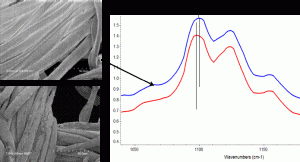Our current project, which examines the interactions between silicones and fabrics, is aimed towards designing optimum surfactants and process schemes. Our primary objective is to establish a relationship between substrate properties and the particle size and surface charge of silicone emulsions as a function of their chemical structure that are used to treat them. AFM was used as a tool to monitor the surface modification of fibers.
It was observed that the treated fibers are far more smoothened, relaxed and uniform as compared to the untreated. Thus the morphology of the fabric is modified by treatment with specialty silicones. Furthermore, these results give a microscopic insight into the macroscopic properties such as softness and antiwrinkle of the silicone treated fabrics.
FTIR and Raman studies of fibers were undertaken to understand the interactions of silicone polymers with fabric substrates. Raman has been employed to understand the stress-strain behavior of fabrics originating from different source materials or having undergone different treatments (H. Liem 2007, Eichhorn 2003). Raman band of C–O ring stretching mode at 1095 cm-1 shifts toward lower wavenumber during tensile deformation of fibers (shown in figure below). Magnitude of the shift depends upon the chemical structure, morphology, and microstructure of fibers. We observed lowering of stress from the Raman spectra of treated fibers i.e. a shift towards higher wavenumber suggesting relaxation of fibers.

